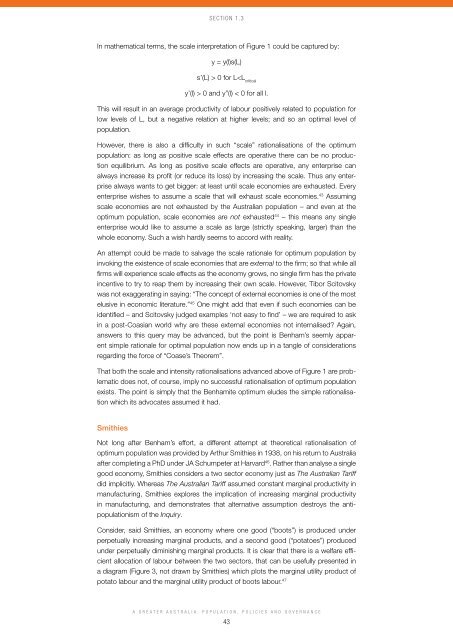A Greater Australia: Population, policies and governance - CEDA
A Greater Australia: Population, policies and governance - CEDA
A Greater Australia: Population, policies and governance - CEDA
- No tags were found...
You also want an ePaper? Increase the reach of your titles
YUMPU automatically turns print PDFs into web optimized ePapers that Google loves.
Section 1.3In mathematical terms, the scale interpretation of Figure 1 could be captured by:y = y(l)s(L)s’(L) > 0 for L 0 <strong>and</strong> y”(l) < 0 for all l.This will result in an average productivity of labour positively related to population forlow levels of L, but a negative relation at higher levels; <strong>and</strong> so an optimal level ofpopulation.However, there is also a difficulty in such “scale” rationalisations of the optimumpopulation: as long as positive scale effects are operative there can be no productionequilibrium. As long as positive scale effects are operative, any enterprise canalways increase its profit (or reduce its loss) by increasing the scale. Thus any enterprisealways wants to get bigger: at least until scale economies are exhausted. Everyenterprise wishes to assume a scale that will exhaust scale economies. 43 Assumingscale economies are not exhausted by the <strong>Australia</strong>n population – <strong>and</strong> even at theoptimum population, scale economies are not exhausted 44 – this means any singleenterprise would like to assume a scale as large (strictly speaking, larger) than thewhole economy. Such a wish hardly seems to accord with reality.An attempt could be made to salvage the scale rationale for optimum population byinvoking the existence of scale economies that are external to the firm; so that while allfirms will experience scale effects as the economy grows, no single firm has the privateincentive to try to reap them by increasing their own scale. However, Tibor Scitovskywas not exaggerating in saying: “The concept of external economies is one of the mostelusive in economic literature.” 45 One might add that even if such economies can beidentified – <strong>and</strong> Scitovsky judged examples ‘not easy to find’ – we are required to askin a post-Coasian world why are these external economies not internalised? Again,answers to this query may be advanced, but the point is Benham’s seemly apparentsimple rationale for optimal population now ends up in a tangle of considerationsregarding the force of “Coase’s Theorem”.That both the scale <strong>and</strong> intensity rationalisations advanced above of Figure 1 are problematicdoes not, of course, imply no successful rationalisation of optimum populationexists. The point is simply that the Benhamite optimum eludes the simple rationalisationwhich its advocates assumed it had.SmithiesNot long after Benham’s effort, a different attempt at theoretical rationalisation ofoptimum population was provided by Arthur Smithies in 1938, on his return to <strong>Australia</strong>after completing a PhD under JA Schumpeter at Harvard 46 . Rather than analyse a singlegood economy, Smithies considers a two sector economy just as The <strong>Australia</strong>n Tariffdid implicitly. Whereas The <strong>Australia</strong>n Tariff assumed constant marginal productivity inmanufacturing, Smithies explores the implication of increasing marginal productivityin manufacturing, <strong>and</strong> demonstrates that alternative assumption destroys the antipopulationismof the Inquiry.Consider, said Smithies, an economy where one good (“boots”) is produced underperpetually increasing marginal products, <strong>and</strong> a second good (“potatoes”) producedunder perpetually diminishing marginal products. It is clear that there is a welfare efficientallocation of labour between the two sectors, that can be usefully presented ina diagram (Figure 3, not drawn by Smithies) which plots the marginal utility product ofpotato labour <strong>and</strong> the marginal utility product of boots labour. 47A <strong>Greater</strong> <strong>Australia</strong>: <strong>Population</strong>, Policies <strong>and</strong> Governance43





